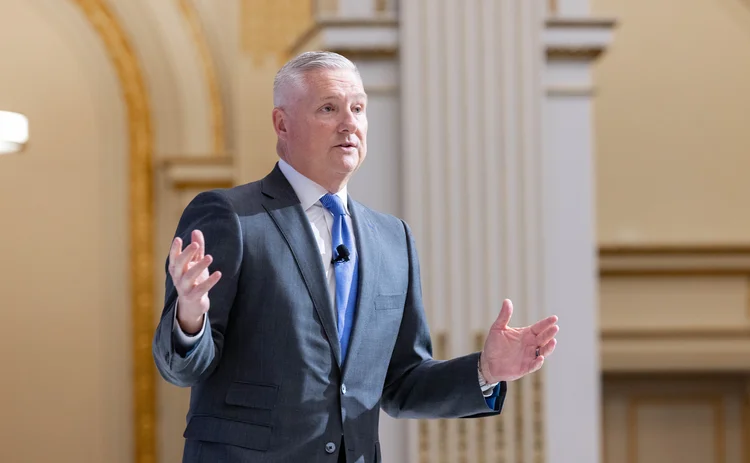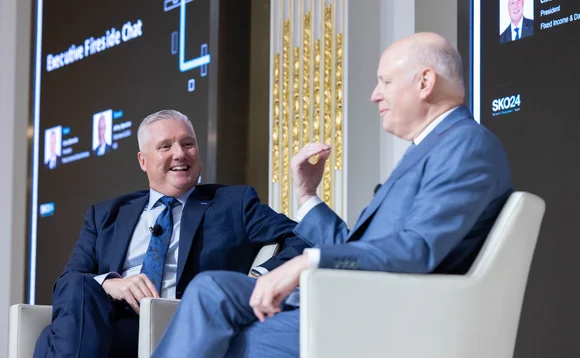Chris Edmonds takes the reins at ICE Fixed Income and Data Services
Edmonds is now leading ICE’s fixed income and data business as the rush to provide better data and analytics in fixed income builds.

Chris Edmonds and Jeffrey Sprecher first met in the late ‘90s. Sprecher’s Intercontinental Exchange, or ICE, was in its infancy, aiming to provide a network for over-the-counter energy commodity trading. Edmonds was working his way up the corporate ladder in the energy trading business, where he had started in 1997 as an OTC natural gas broker at ICAP. In essence, the two were competitors.
But today, Edmonds says he was impressed with ICE’s ability to see the market not just in terms of dollar signs and math problems, but technology and how it would shape the future. “I would have debated them at the time that they didn’t understand pieces of the market, because I didn’t understand the technology of what they were trying to do,” he says. “But just the success they achieved, having seen them launch and grow this company and what it’s become, it doesn’t take a whole lot of intelligence to know you want to be a part of that.”
That vision has paid off for ICE. It operates futures exchanges, the New York Stock Exchange, OTC energy and credit markets, and clearinghouses, just to name a few of its business lines. A 2013 profile of Sprecher and ICE that was published on the heels of the $8.2 billion proposed acquisition of NYSE likened the company to other “young companies that are upending the old order in business … ICE has used computer power to do things faster and cheaper, if not always better, than people can.”
In 2008, a few years before that bombshell acquisition, Edmonds was making a career move when he got a call from Sprecher.
“‘Hey, why didn’t you tell me you were leaving?’” Edmonds recalls Sprecher asking. “And I’m like, ‘Well, why didn’t you tell me you’d be interested in my joining ICE?’ And he goes, ‘That’s fair.’” That could have been the end of it, but in 2010, Edmonds found himself again making a pivot and Sprecher was his first call. Soon thereafter, Edmonds joined ICE to run the credit default swap clearinghouse, ICE Clear Credit, in Chicago.
“We often remind each other of that, and he also reminds me that when we were competing, his vision for the future of markets was right, and that’s why I worked for him,” Edmonds says.

Fourteen years later, he’s become a fixture at ICE, having worn multiple hats across the business. He’s served as global head of clearing and risk, senior vice president of financial markets, and ICE’s chief development officer. But this past January, Edmonds stepped into even bigger shoes as the president of ICE Fixed Income and Data Services (FIDS).
Sprecher, the founder and CEO of ICE, tells WatersTechnology that since Edmonds joined the exchange group to help build ICE Clear Credit, he’s become a strong leader on the company’s management team. “Over the years, he’s helped us navigate the evolving CDS market, expand our global sales team, overhaul our global clearinghouse operations, and steer our regulatory efforts in Washington and beyond. Chris has always had the voice of our customers ringing in his head, and he’s already applying his deep industry experience to take our fixed-income and data services business to the next level,” Sprecher says.
Edmonds is stepping into his new role at an inflection point for the business. Over the last few years, ICE has made several acquisitions in the mortgage technology space, building out an offering that touches every step in the lifecycle of a mortgage. Sprecher told Fortune Magazine last fall that the venture represented the “biggest untapped opportunity in financial services.”
The data opportunity is as immense as it is daunting. Effective trading in fixed income requires timely and accurate data, and AI and machine-learning strategies are becoming more prevalent in this particular asset class. Edmonds has deep and murky waters to navigate.
Repeating history
In 2015, ICE made waves in the world of exchanges when it bought Interactive Data. A year later, it added S&P Global’s Standard & Poor’s securities evaluations business, and Credit Market Analysis, a data provider for the OTC markets, including credit derivatives and bonds. It followed those acquisitions with the addition of Bank of America’s Global Research division’s fixed-income index platform and a month later, ICE announced its intention to acquire BondPoint from Virtu Financial. In the summer of 2018, it closed its deal for TMC Bonds.
The acquisition spree was specifically targeting fixed income and ultimately culminated in a data treasure trove for the fixed-income markets. Lynn Martin, who was then president of FIDS, detailed to WatersTechnology in 2020 how ICE was approaching its business segments, where each one is its own “ecosystem” that, combined, brings together a massive data offering.
That ecosystem approach is being deployed once again in the mortgage technology space. The pivot started with the 2018 acquisition of the Mortgage Electronic Registrations Systems (MERS), a national electronic registry that tracks the changes in servicing rights and beneficial ownership interests in US-based mortgage loans. Seen as the “golden source” of the mortgage industry, it contains information related to 85% of loans in the United States. In 2019, ICE added Simplifile, an electronic liaison between lenders, settlement agents, and county recording offices, streamlining the public recording of residential mortgage transactions.
Next, in 2020, came Ellie Mae, a cloud-based platform provider for mortgage origination. Rounding out this latest M&A binge was Black Knight, a servicing provider, whose acquisition was completed last fall. Its price tag coming in at a hefty $11.9 billion. ICE is now able to service the entirety of the mortgage ecosystem from the time a loan is locked from a rate perspective to payment collections.
“Look at the data that’s available from the moment someone begins a mortgage application all the way to the performance of a mortgage-backed security that an individual loan sits in, and we have the full gamut of that,” Edmonds says. “We get to touch many different parts of the space in a very consistent manner, giving the ability for the client to have that experience, no matter where they are in the lifecycle.”
The data opportunities are plentiful across the mortgage spectrum. Data from origination can be used by banks to understand where interest rates are going while servicing offers data around prepayments and defaults, which is crucial to both the mortgage industry and the mortgage-backed securities market.
ICE has already created data products from the mortgage ecosystem. Using mortgage rate lock data, the data services team put together an index at the end of 2021. When home buyers apply for a mortgage and are given their commit letter and their interest rate is locked, ICE is able to see that for about half of the loans originated in the US. Prior to that, mortgage rate data was all survey-based, and not derived from real transactions.
“You’ve heard our CEO talk about the analog to digital transformation,” Edmonds says. “If you think about the analog to digital, you can think about that as a horizontal line or the breadth of our coverage. And then if you look at the other transactions we’ve done along the way, I can use mortgage, I can use fixed income—either way we start to increase the depth of our coverage.”
Martin, who is now president of the New York Stock Exchange and chair of ICE FIDS, says Edmonds brings a deep understanding of the markets ICE operates as well as the regulatory environment across the globe. “He’s also someone who is very customer-focused, which is a unique attribute that he brings to the role,” she says.
The roots of that can be traced back to Edmonds’ days as an OTC broker. At first, the ins and outs of the job perplexed him. “Wait, I gotta sit on a desk and yell through a phone to some nameless, faceless person on the other end for 10 hours a day?” he says, reflecting back. It took him a while to warm up to the competitive environment, but more than 25 years later, the lessons of the job have stayed with him.
In January, during the sales kick-off for the year, he emphasized to his team three key themes he wanted them focused on: intention, purpose, and team. These principles find their origins in his OTC broker days. “When you’re an over-the-counter voice broker, you understand what your intentions are, you understand the purpose you serve, and you certainly understand how it impacts the team, which is inclusive of the client,” he says. “I need to know their kids’ names. I need to know where they go to university. I need to know where they go to daycare. I need to know what’s important to him or her because I can’t really understand the true needs of the client unless I understand them as a human. And so I’m really encouraging the team to understand the relationships they have along the way.”
In his previous role as chief development officer, Edmonds had two responsibilities. He oversaw ICE’s clearinghouses while managing the company’s marketing and public relations campaigns. “It was really about telling our story, either to regulators, clients, stakeholders, or other government authorities that weren’t directly regulators,” he says.
In moving from chief development officer to the president of FIDS, Edmonds is taking the relationships he’s created with clients and building on it. “Now understanding how data impacts not only how they view [data] but then manage the risk in their books, gives me an opportunity to come in with a high level of understanding of their needs, and the ability to explain our products and services and how we can help them,” he says.
Edmonds will now oversee a staff of roughly 2,300 and the change in title will also move him from Chicago to Atlanta. The role was originally headquartered in New York, but as the role has grown globally, it made sense for ICE’s strategic direction for the FIDS president to sit in Atlanta with the rest of senior leadership. The South is familiar to Edmonds; he has an unmistakable twang, and he’s an alumnus of the University of Alabama at Birmingham.
ICE’s strategic direction for its data business has Edmonds excited about the role he’s taken on. Edmonds boils it down to the opportunities in innovation. “I thought it’d be an interesting time in my career, to be at the crossroads of newer technologies that rely upon incredible datasets to create their output, to have a front-row seat at that intersection.”
ICE is also examining its role in the buzz around AI. As data providers appear to be the most well-suited in harnessing generative AI and large language models, ICE is positioning itself as the provider of the datasets that clients will look to as they employ models or predictive analytics into their firms. Valuable, clean, structured and unstructured data from across business lines will be at the heart of that. Fixed-income evaluations, index and reference data, mortgage data, CDS data, equities, options, and futures data are all on the table as viable datasets for clients. “They’re going to need our data at the end of the day in order to drive those models and we look forward to those conversations,” Edmonds says.
Large language models aren’t unknown territory for ICE. During the 2023 Q2 earnings call, Martin reported a 60% increase in the number of transactions executed via its ICE Chat messaging service as a result of refining proprietary large language models that help automate trading over the platform. Martin said the exchange had used LLMs in its ICE Chat offering for “quite some time,” starting with early steps around a decade ago, but added that these have been significantly refined over the past five years, and have become a contributor to growing transactions in its energy markets, including oil, gas, and utilities markets.
Ultimately, it’s a simple formula that ICE is using: increased electronification of markets means more data. “Data is the thread that pulls all of ICE together if you think about each of our three different segments,” Martin says. “As a result of there being more and more outputs of data, there are more and more insights to glean off of. And if you’re able to package those insights into a usable normalized format, customers are going to be able to manage risk and execute processes a heck of a lot more efficiently.”
At the core of that is the creation of technology to drive that electronification. It’s the same thing that Edmonds saw ICE doing in the late 1990s, even if he didn’t fully understand back then how that strategy would affect his mission a few decades later.
“We’re not an exchange group or a venue that is needing to buy technology—we create technology,” he says. “Obviously, you need good data to do that, and you need the ability to create and manage good data to bring that automation to bear.”
Only users who have a paid subscription or are part of a corporate subscription are able to print or copy content.
To access these options, along with all other subscription benefits, please contact info@waterstechnology.com or view our subscription options here: http://subscriptions.waterstechnology.com/subscribe
You are currently unable to print this content. Please contact info@waterstechnology.com to find out more.
You are currently unable to copy this content. Please contact info@waterstechnology.com to find out more.
Copyright Infopro Digital Limited. All rights reserved.
You may share this content using our article tools. Printing this content is for the sole use of the Authorised User (named subscriber), as outlined in our terms and conditions - https://www.infopro-insight.com/terms-conditions/insight-subscriptions/
If you would like to purchase additional rights please email info@waterstechnology.com
Copyright Infopro Digital Limited. All rights reserved.
You may share this content using our article tools. Copying this content is for the sole use of the Authorised User (named subscriber), as outlined in our terms and conditions - https://www.infopro-insight.com/terms-conditions/insight-subscriptions/
If you would like to purchase additional rights please email info@waterstechnology.com
More on Trading Tech
Bank-led consortium takes aim at position reporting
Five banks, including Barclays, BNP Paribas, Goldman Sachs and HSBC, have joined forces to mitigate interpretation and implementation errors in position reporting disclosures.
This Week: BBH, AllianceBernstein add data solutions, Deutsche Börse-Nodal Exchange, and more
A summary of some of the latest financial technology news.
Consortium backs BGC’s effort to challenge CME
Banks and market makers—including BofA, Citi, Goldman, Jump and Tower—will have a 26% stake in FMX.
Symphony boosts Cloud9 voice offerings with AI
The messaging and collaboration platform builds on Cloud9’s capabilities as it embraces the AI wave in what CEO Brad Levy calls “incremental” steps.
Can exchanges leverage new tech to claw back ETF share from RFQ platforms?
Systematic trading strategies and proliferating data are bringing efficiency to an otherwise-fragmented European ETF market.
Nasdaq reshuffles tech divisions post-Adenza
Adenza is now fully integrated into the exchange operator’s ecosystem, bringing opportunities for new business and a fresh perspective on how fintech fits into its strategy.
Liquidnet sees electronic future for gray bond trading
TP Icap’s gray market bond trading unit has more than doubled transactions in the first quarter of 2024.
This Week: HKEx's new derivatives platform; GoldenSource; Quonian-SimCorp, and more
A summary of some of the latest financial technology news.
Most read
- DTCC urges affirmation focus ahead of T+1 move
- Women in Technology & Data Awards 2024: All the winners and why they won
- FactSet looks to build on portfolio commentary with AI








